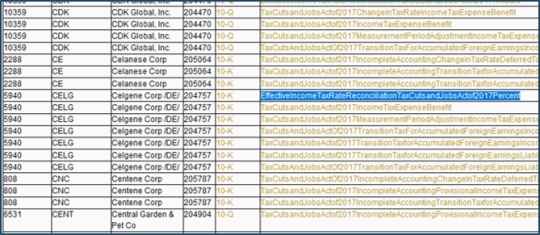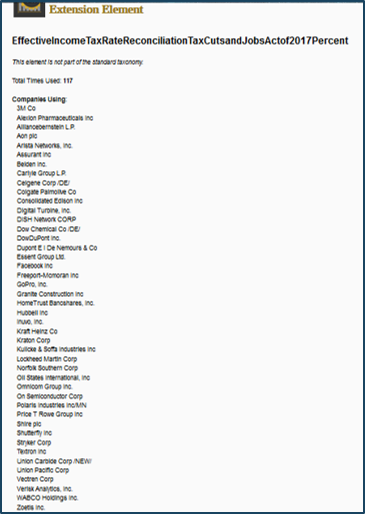Before we go further poring over corporate disclosures related to tax reform, we wanted to take a step back and give Calcbench subscribers a better sense of how to find all these disclosures.
The best place to start is with our Interactive Disclosures tool. There, you can easily find any company’s disclosures on income taxes. Just open the pull-down menu on the left side for Notes to Financial Statements, and you’ll see a choice for “Income Taxes.” Click on that, and the income tax disclosures appear.
(Aside: you’ll also see a choice to download our Guide to Income Tax Disclosures, which is a great primer on what Calcbench can do for you before you dive into the data.)
You can also try to use the XBRL Data Query Tool, which lets subscribers search for financial data based on how a company “tags” that piece of data. For example, you can search for numbers tagged as “revenue,” “operating income,” “severance costs” and all sorts of other terms. (We have a whole separate post about how to use the XBRL Query tool from several months ago.)
Alas, we do have one caveat with search tax disclosures via XBRL tags: since tax reform is so new, companies are using extension tags to describe their data related to tax reform. Extensions are tags companies create themselves, rather than using those dictated by the official taxonomy for U.S. Generally Accepted Accounting Principles.
So while most companies are using extension tags that are similar, those tags aren’t always identical.
How to Get Around That
Intrepid data nerds that we are here, Calcbench decided not to let the extension tags stop us. We used the XBRL Query tool and searched for “TaxCuts” mentioned in 2017 filings, assuming that any tag referencing tax cuts would use those actual words. (XBRL tags do not use spaces between words.)
Result: dozens of companies already citing the effects of tax reform so far, and we’ve just begun to receive 2017 reports from the S&P 500. So as filing season continues into the spring, eventually we’ll see thousands of filers mentioning tax reform in one way or another. See Figure 1, below.

Here’s where it gets interesting. Thanks to our Calcbench database superpowers, you can see how many companies use the same extension — and many do, because they’re describing the same concept. For example, look at Celgene in Fig. 2 below.

You can see in that highlighted line that it describes its new effective tax rate as “EffectiveIncomeTaxRateReconciliationTaxCutsandJobsActof2017Percent.” And that tag is a hyperlink; if you click on it, you can see all the other companies that have filed financial statements using that exact same extension. In this case, 43 companies used that tax a total of 117 times. (Fig. 3, below.)

Now we’re getting a sense of comparability; you know at least some of the companies that are disclosing an effective tax rate specifically for 2017, this first year of tax reform where effective rates might go a bit haywire. From there you can go back to the Interactive Disclosures page or the Company-in-Detail page to do further research, and see what those filers had to say. Yes, other filers might also report an effective rate using some other tag; we would need to do a lot more homework to develop a complete list. This, however, at least gets you started.
In the fullness of time Calcbench will have much more to say about tax reform and reconciliation items. But, as always, you can do your own exploring too!